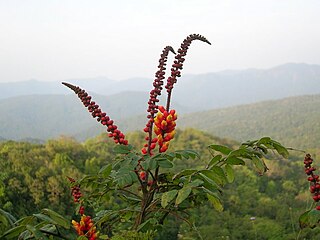
Calliandra is a genus of flowering plants in the pea family, Fabaceae, in the mimosoid clade of the subfamily Caesalpinioideae. It contains about 140 species that are native to tropical and subtropical regions of the Americas.

Libidibia ferrea, formerly Caesalpinia ferrea, and commonly known as Brazilian ironwood, leopardtree or jucá, is a tree found in Brazil.

Piptadenia is a genus of tropical shrubs and trees of the family Fabaceae. It includes 28 species native to the tropical Americas, ranging from central Mexico to southern Brazil and northwestern Argentina.

Chamaecrista is a genus of flowering plants in the pea family, Fabaceae, subfamily Caesalpinioideae. Members of the genus are commonly known as sensitive pea. Several species are capable of rapid plant movement. Unlike the related genera Cassia and Senna, members of Chamaecrista form root nodules.

Chloroleucon is a genus of flowering plants in the family Fabaceae. It contains 11 species native to the tropical Americas, ranging from Mexico through Central America, the Caribbean, and South America to northern Argentina. Some authorities consider it part of the genus Albizia. Its name is derived from the Greek words χλωρóς (chloros), meaning "green," and λευκός (leukos), meaning "white."

Cratylia is a genus of legume in the family Fabaceae. It includes eight species native to tropical South America, from Peru and northern Brazil to northeastern Argentina.

Zygia is a genus of flowering plants in the family Fabaceae. It includes 60 species of tres and shrubs native to the tropical Americas, from Southern Mexico and Cuba to northern Argentina. Typical habitats are tropical forest and coastal zones, generally below 900 meters elevation with a few species extending up to 2800 meters. It belongs to the mimosoid clade of the subfamily Caesalpinioideae.

Hoffmannseggia is a genus of flowering plants in the pea family, Fabaceae, known generally as rushpeas. These are pod-bearing herbs and subshrubs native to the Americas. In North America they range from California and Nebraska to southern Mexico, and from Colombia, Ecuador, and Peru to southern Argentina and Chile in South America. The generic name honors Johann Centurius, Count of Hoffmannsegg, a nineteenth-century German nobleman and botanist.
Cenostigma is a genus of flowering plants in the family Fabaceae. It includes 15 species native to the tropical Americas, ranging from Mexico to northwestern Argentina and southern Brazil. It belongs to the subfamily Caesalpinioideae and tribe Caesalpinieae. Cenostigma pluviosa is being investigated as a possible antimalarial medication.

Moullava is a genus of flowering plants in the legume family, Fabaceae. It includes four species of lianas or scrambling shrubs native to tropical Africa from Cameroon to Tanzania and Angola, and to tropical Asia from India to Indochina, southern China, and western Malesia. Typical habitat includes forest margins of seasonally-dry semi-evergreen tropical forest. It belongs to the subfamily Caesalpinioideae.
Pomaria is a genus of flowering plants in the legume family, Fabaceae. It includes 16 species of shrubs and perennial herbs native to North America, South America, and southern Africa. Typical habitats include drier subtropical grasslands and wooded grasslands, often on limestone, and degraded areas. It belongs to tribe Caesalpinieae of subfamily Caesalpinioideae.

Senegalia is a genus of flowering plants in the family Fabaceae. It belongs to the Mimosoid clade. Until 2005, its species were considered members of Acacia. The genus was considered polyphyletic and required further division, with the genera Parasenegalia and Pseudosenegalia accepted soon after.
Pityrocarpa is a genus of flowering plants in the family Fabaceae. It includes seven species of shrubs and small trees native to the tropical Americas, including western and southeastern Mexico, Guatemala and El Salvador, Venezuela and Guyana, Bolivia, and eastern Brazil. Native habitats include tropical coastal rain forest, gallery forest, secondary forest, woodland, wooded grassland (Cerrado), and thorn scrub (Caatinga). It belongs to the mimosoid clade of the subfamily Caesalpinioideae.

Harpalyce is a genus of flowering plants in the family Fabaceae. It belongs to the subfamily Faboideae. It includes 35 species of shrubs and small trees native to the tropical Americas. Their distribution is disjunct, ranging from Mexico to Nicaragua, Cuba, and northern to southeastern Brazil and Bolivia. Typical habitats include seasonally-dry tropical forest, warm-temperate humid forest, woodland, bushland and thicket, shrubland, and grassland. Most species are evergreen and flower during the dry season.

Macropsychanthus is a genus of flowering plants in the legume family, Fabaceae. It belongs to the tribe Diocleae, subfamily Faboideae. The genus has 47 species with a pantropical distribution, ranging through the tropical Americas from southern Mexico to northeastern Argentina, west and central Africa, Madagascar, Indochina, Malesia, Papuasia, and Queensland.

The tribe Caesalpinieae is one of the subdivisions of the plant family Fabaceae: subfamily Caesalpinioideae.
Erythrostemon is a genus of flowering plants in the legume family, Fabaceae. Its native range is tropical & subtropical America.

Tara is a genus of flowering plants in the legume family, Fabaceae. It includes three species of trees and shrubs native to the tropical Americas, from northern Mexico through Central America, the Caribbean, and western South America to Bolivia and Central Chile. Typical habitats include seasonally-dry tropical forest and semi-arid thorn scrub. It belongs to tribe Caesalpinieae of subfamily Caesalpinioideae.














